|
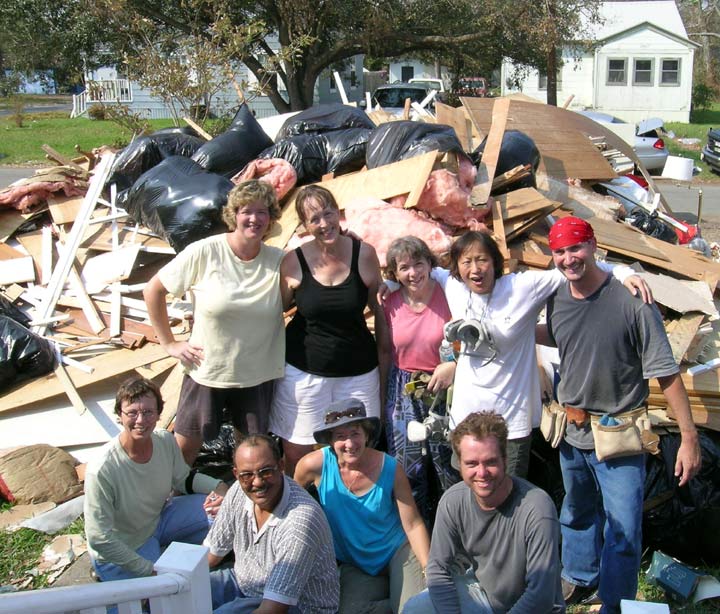
Cal-Nevada Conference Team Aids Katrina Clean-Up
An eight-person team of volunteers
from a half-dozen Methodist Churches in Northern California was among the dozens of VIM (Volunteer in Mission) teams that descended on
the Mississippi Gulf
Coast last week to help with the clean-up of damage inflicted on the
area by Hurricane Katrina.
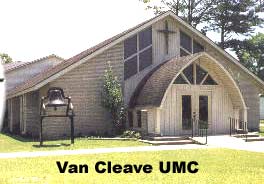
|
| VIM Headquarters on the Mississippi Gulf Coast |
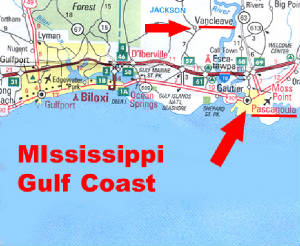
Vancleave UMC is a major center for the Gulf Coast clean-up and is the command center for Robert Sharp, the UMVIM coordinator for Mississippi’s Seashore District, which includes the six southernmost
counties that suffered the bulk of the state’s serious damage. Sharp is
working closely with Vancleave Pastor Larry Maugh who has turned every spare room in his church and Sunday School into a dormitory
for volunteer workers.
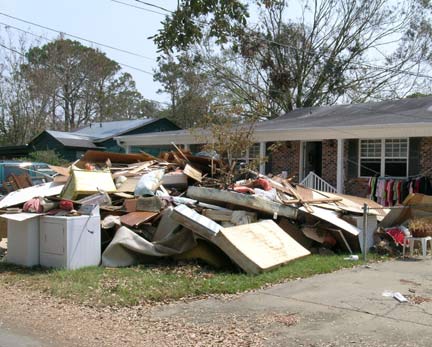
The Cal-Nevada Conference team arrived on
Friday, Sept. 9 and immediately began work helping flood victims deal with the devastation suffered in what may be the
worst natural disaster in U.S. history. The
local group worked out of the Vancleave Methodist
Church which is located about eight miles north of the Gulf Coast.
They and other volunteers are concentrating their efforts on three of the hardest hit areas on the coast—Gulfport, Biloxi and Pascagoula.
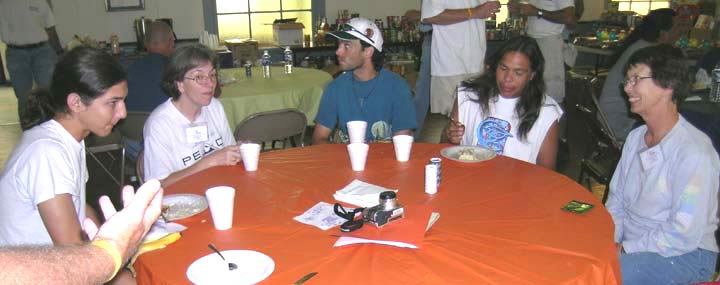
|
| Californians and Oklahoma Cherokee Native Americans sharing breakfast at Vancleave UMC |
A half-dozen native Americans from a Cherokee tribe in Oklahoma were the first to arrive on Thursday, September 8 and they were followed the next
day by the Northern Californians. By the following day, the Vancleave church was filled beyond
its original capacity of 30 with more than 40 volunteers from Michigan, North
Carolina, Georgia, Alabama,
South Carolina and Florida. A contractor from North Carolina
is a one-man team who has promised to stay for three weeks. Montgomery’s
Frazer Memorial Church, one of the largest in the South, sent 12 volunteers on Saturday and, according to Sharp, has promised
to keep rotating 12- to 15-person teams continuously on site “until the job is finished.”
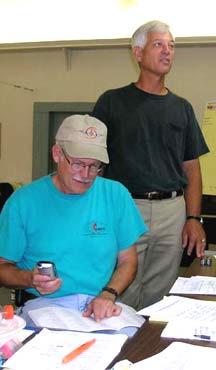
|
| Robert Sharp and Rev. Larry Maugh |
This could be a long time, according
to Sharp. With more than 100,000 families in heavily damaged or destroyed homes,
he is predicting that the clean-up and reconstruction of homes could keep VIM teams busy for up to four years. “There is no way to describe the extent of the destruction or
the number of homes that were damaged,” said Sharp. Sharp is no stranger
to hurricanes. As a 32-year veteran of the Air Force’s ‘Hurricane
Hunters’ he has flown into the eye of more than 400 Atlantic and Gulf storms.
Sharp
and his small staff of volunteers are busy collecting names of Gulf Coast families who are trying to deal with the loss of
virtually all of their belongings and who have been rendered homeless by the surge of water that came ashore and filled their
houses with two to eight feet of swirling ocean surf. It is in these homes that
the VIM teams are concentrating their efforts. Each day many families contact Sharp seeking help in putting their lives
back together.
When Sharp returns to his day job,
he will be replaced by Buck Baxter, a volunteer from Montgomery's Frazer UMC. Baxter has offered to stay on "as long
as they need me" in order to coordinate the VIM clean-up project.

|
| Peggy Land chipping parquet flooring--piece by piece. |
In order to make the homes habitable, the teams must spend more than a day in each
home, removing all of the family’s furniture and possessions, pulling up the carpet or chipping up the flooring, and
then removing most of the interior walls and insulation. Because of the danger posed by the mold, volunteers wear respirators
or surgical masks (depending upon the degree of the mold's proliferation). By the time volunteers finish with
a house, they have created a 10-foot high mountain of furniture and waste in the front yard. Tens of thousands of houses
in the area have these enormous piles of debris piled at their curbside, awaiting removal by trucks that will be provided
by FEMA
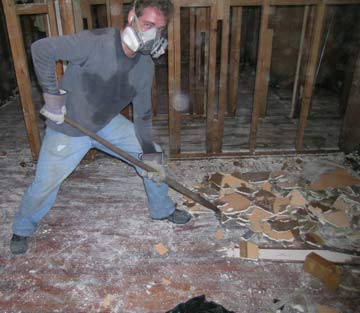
|
| Chris Wenger shoveling sheetrock |
This process allows the house to dry out and arrests the spread of mold which begins
to grow as soon as the flood waters recede. After several weeks or more of drying,
it is possible that families with the necessary resources will be able to start reconstruction—sheetrocking the walls,
replacing molding, and laying new carpet. Resources are the primary problem: Sharp explains that less than 10 per cent of the families on the Gulf
Coast were able to afford costly flood insurance. In both the flood damage and reconstruction phase, Sharp is attempting to focus his district’s efforts
on the elderly and poor families who have little ability to help themselves recover.
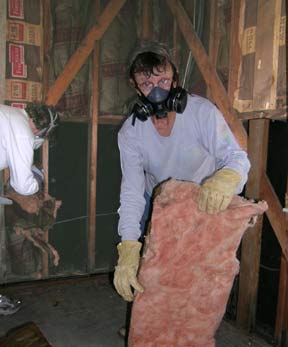
|
| Gayle Holz removing insulation |
Virtually every Methodist Church in
the Seashore District is involved to some degree in the recovery effort, even those that suffered substantial damage themselves. For example Eastlawn UMC in Pascagoula was serving as a distribution point for food
and clothing for many of the areas’s poorest families, long before it started to clean up its own sanctuary, Sunday
school and social hall which were inundated with four feet of water and which eventually will need the same rehabilitation
as the houses which are the target for work by the VIM teams. Several UMC churches
closer to the beach were not as lucky as Eastlawn and were virtually destroyed by the tidal surge that accompanied Katrina. One of the biggest losses occurred in Biloxi
where the Leggett Memorial UMC was completely gutted by the storm waters, along with a number of buildings that served as
a conference and retreat center.
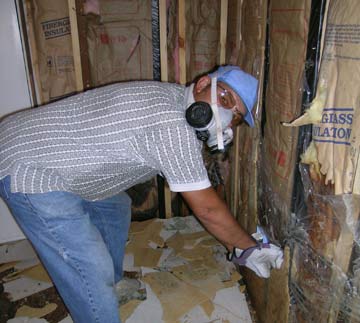
|
| Honorary Californian Jim Webb (from North Carolina) |
The state’s overall effort is being
coordination by Conference VIM Director Robert McCoy, pastor of the Baldwyn UMC. He
is hoping to see “between 90 and 150 VIM teams from all over the country” show up in the months to come. But, according to McCoy, the need for help will extend well beyond a few months. Once the clean-up is completed, it will take “years and years” of participation
by VIM crews to help rehabilitate the damaged homes in the state.
Vancleave
Pastor Maugh is uncertain how long his church will be able to continue its current program of housing 15 to 45 volunteer workers
a night, but he promises, “We’ll keep going as long as there is someone who needs our help.” The Frazer church in Montgomery is underwriting many of the costs being borne by the small Vancleave
Church, whose parishioners have been working dawn to dusk cooking meals, washing clothes and sheets, and providing the other
help necessary to support the volunteer effort. A major player is Maugh’s
wife Celeste who coordinates most of the logistical arrangements such as scheduling incoming groups, arranging for cooks and
cleaners, and ensuring that food, water and other supplies are on hand.
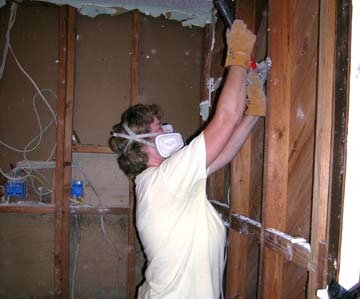
|
| Denise Austin pulling nails from studs |
Cal-Nevada VIM Director J.P.McGuire
is hoping that California will be a major participant in the program.
He was able to help organize the arrival of the first group within a week after the disaster, but “we need to
send many more.” The first group included two conference pastors (Cheri
Pierre of Willits UMC and Julie Horne of Durham and Chico
Trinity). They were joined by six other volunteers from Paradise (Jim Horne),
Durham (Sylvia Thompson), Trinity (Chris Wenger), Willits (Gayle Holz), and Good Samaritan
of Cupertino (Denise Austin and Peggy Land). They stayed a week at the Vancleave Church
and returned to Sacramento on Thursday, September 15.
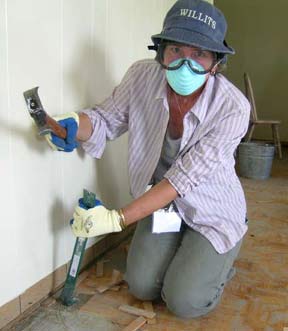
|
| Rev. Cheri Pierre of Willits |
As noted, this first group spent all five days dealing with flood damage at homes in the Pascagoula
area. This involved moving into a house and removing all of the moldings, carpeting,
flooring, most of the walls and insulation. Then other crews came into the homes
to spray a bleach solution designed to arrest the growth of the mold.
Other California groups will be formed in the months
and year to come. One of the first is being assembled by John McCormack of St. Mark's UMC in Sacramento, whose e-mail
address is: firetester@comcast.net. Chico Trinity is hoping to send another team in the spring when the emphasis will be shifting to re-building
the homes that were damaged or destroyed. As a part of the effort, some UMC churches may choose to 'partner' themselves
with one of the damaged churches on the Mississippi Gulf Coast or in southern Louisiana.
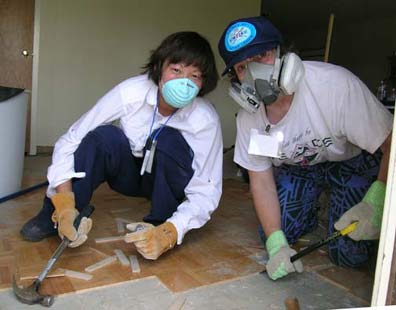
|
| Peggy Land and Pastor Julie Horne |
“The situation here is beyond belief,”
said Pastor Julie Horne. “Virtually every home within a mile of the Gulf
Coast has been made uninhabitable.
Some homes have been completely destroyed with nothing left but the studs in the walls, while others will need hundreds
of hours of work to be made safe. Then there are those homes, mainly in the poor
areas, that were not in good shape before the flood, and which are now so heavily damaged that they are not worth repairing.”
“Ironically,”
said Pastor Horne, “most of the media attention has been focused on New Orleans, but
the center of the hurricane actually hit and did most of the immediate damage all along the Mississippi Gulf Coast. The scale of suffering here is beyond belief.”
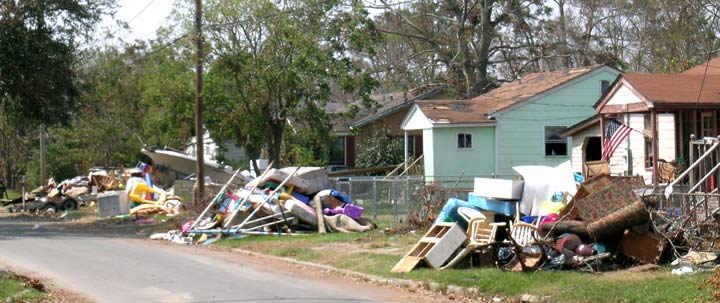
|
| Typical Scene on thousands of blocks on Mississippi's Gulf Coast |
|

